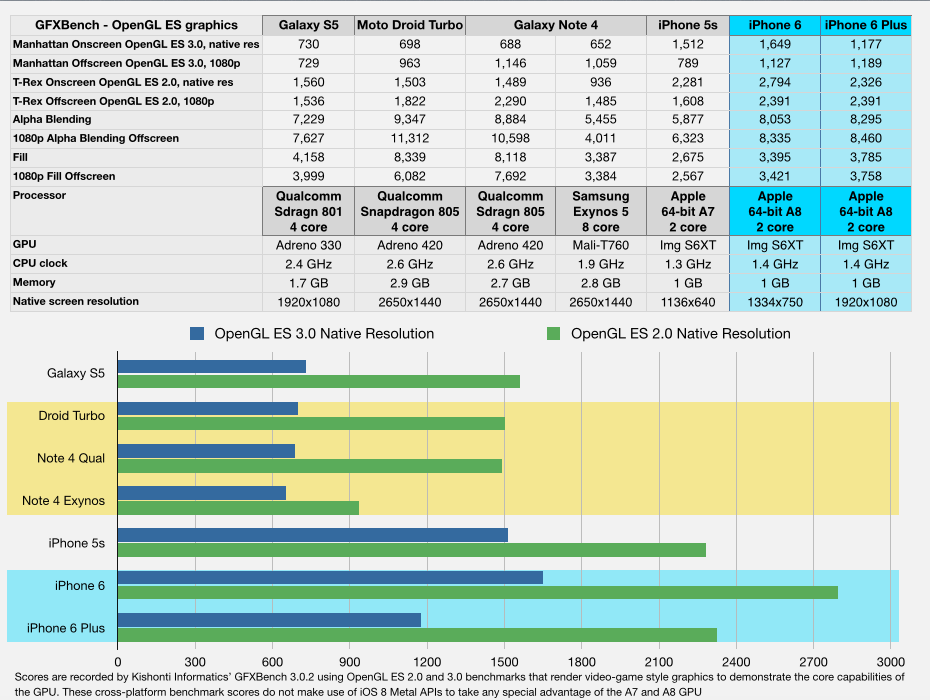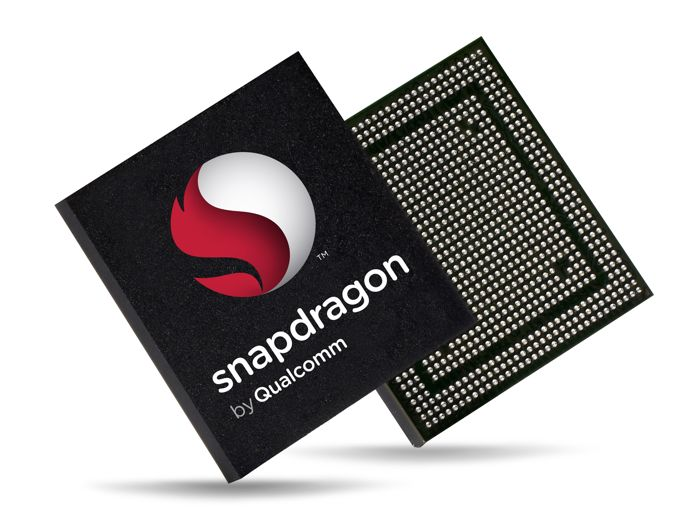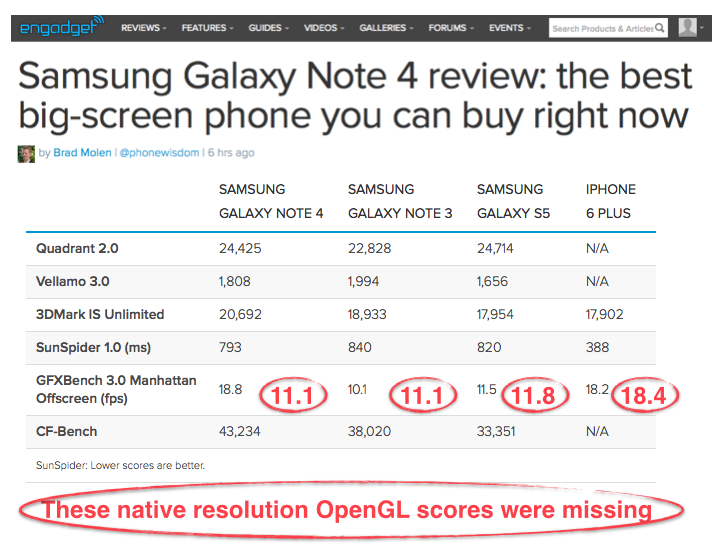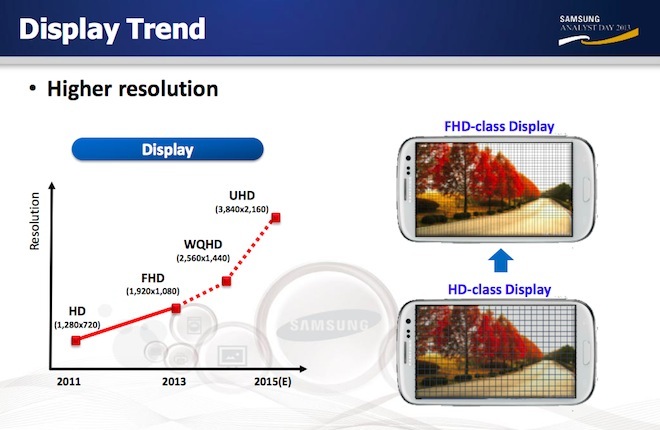Despite using one of the fastest Qualcomm mobile Application Processors now available, Google's new Nexus 6 and Samsung's Galaxy Note 4 fall flat in running GPU intensive apps and games— particularly in comparison to Apple's iPhone 6 Plus.
The first benchmarks showing off the actual performance users will get from these new Android "phablet" models highlight that Samsung and Google's other Android licensees appear to be making the wrong engineering choices, and that by itself, Apple is maintaining— and advancing— its lead over other mobile hardware manufacturers and chip designers.
Qualcomm Snapdragon beats Samsung Exynos
AppleInsider previously detailed Samsung's struggling efforts to build its own Exynos 5 "Octa-core" Application Processors for use in its most expensive Galaxy S5 and Note 4 products sold in a few markets internationally. While Samsung heavily markets its "Octa-core" Exynos chip, the majority of the company's Galaxy devices actually ship using more conventional quad-core chips from Qualcomm.
The latest Galaxy Note 4 uses Qualcomm's Snapdragon 805, which incorporates Adreno 420 graphics. Motorola's new Droid Turbo and its Google-branded Nexus 6 (just announced today) also use the Snapdragon 805, similarly clocked at 2.6-2.7 GHz. All of these also use the same 2560x1440 resolution as the Note 4.
Now that the first Qualcomm-powered Note 4 models have shipped, we can compare real-world Snapdragon 805/Adreno 420 graphics with Apple's A8. The results are not surprising: just as with Samsung's Exynos chips, Snapdragon delivers impressive low level graphics performance that falls completely flat in actually rendering OpenGL ES 3.0 at the native resolution of these Android devices.
With Intel and AMD having little to offer mobile makers, Qualcomm is the primary Application Processor supplier for high end Android devices, particularly since Texas Instruments pulled out of the consumer market and abandoned work on its own OMAP 5 chips.
The other major, high volume chip design family is Apple's own Ax series, which Android licensees have no access to. Last year's A7 chip gained a 64-bit architectural lead over Qualcomm, in addition to featuring an advanced GPU by Imagination Technology: its PowerVR Series6 "Rogue" architecture. This year, Apple has maintained its 64-bit lead while greatly enhancing power efficiency, enabling its slower clocked A8 with less RAM to match or beat the raw performance of 32-bit Qualcomm-powered devices and Samsung's 32-bit Exynos-powered Galaxy products. Moving from Samsung's Exynos to a Qualcomm 805 doesn't help much: the Adreno-powered Note 4 delivered 11.1 fps in the same test, almost half that of iPhone 6 Plus
More importantly, however, Apple has designed elements of its products together, achieving far better real world performance. The native resolution onscreen performance of iPhone 6 and 6 Plus reaches 25.9 and 18.4 fps respectively (in tests that make no use of Apple's Metal API to radically improve the performance of games and other graphics-intensive apps).
The difference in those scores is attributable to the extra pixels on iPhone 6 Plus. AppleInsider previously reported that Apple's leap to a Retina HD 1080p screen on iPhone 6 Plus resulted in graphics that were in some cases slower at their native resolution than last year's iPhone 5s: rendering a challenging OpenGL ES 3.0 3D scene dropped frame rates from 24.4 to 18.4 fps. In the middle, iPhone 6 achieved 25.9 fps.
Unsurprisingly, Samsung's own even-higher resolution Note 4 (or equally high resolution Galaxy S5 flagship) both turn in benchmarks far lower than Apple's new 6 Plus— and less than half that of last year's iPhone 5s. In terms of fps, benchmarks show that Samsung's Exynos-powered Note 4 drops down to 10.5 fps— almost half that of iPhone 6 Plus— in the same test.
Moving from Samsung's Exynos to a Qualcomm 805 doesn't help much: the Adreno-powered Note 4 delivered 11.1 fps in the same test of Open GL ES 3.0, and the similarly configured Motorola Droid Turbo only achieves 11.3 fps. This is data publicly available from Kishonti Informatics' GFXBench.
Engadget's phony report of competitive Note 4 graphics performance
Brad Molen, writing for Engadget under the headline "Samsung Galaxy Note 4 review: the best big-screen phone you can buy right now," reviewed these scores and decided to report only the hypothetical "offscreen" numbers, which appear to be flattering to Samsung.
"The numbers essentially confirm something I already knew: This phone is fast and powerful," Molen wrote.
This is completely misleading however, because users don't care how fast the device performs at an artificial level; they care about how it will actually work at real world tasks. The Note 4, just like Motorola's Droid Turbo, Nexus 6 every other Adreno 420-powered Android flagship with 2560x1440 graphics, doesn't have the horsepower to pull its own weight.
The only reason for printing just the "offscreen" numbers is to hide the terrible GPU performance of Google's Android implementation of OpenGL, and terrible spec-oriented engineering choices that create products that are designed to win feature checklist reviews rather than to serve as good products for users.
Bad Engineering Choices
In an apparent effort to win the "spec war," Android licensees— led by Samsung— began aggressively cranking up device resolutions on their most expensive premium flagships after Steve Jobs demonstrated iPhone 4's Retina Display back in 2010. Prior to that, Samsung was internally focused on smaller devices, not larger, higher resolution displays.
In contrast, Apple has only changed its flagship iPhone resolutions twice since then, making iPhone 5 taller and the new iPhone 6 & 6 Plus both larger and more pixel dense in the move to "Retina HD" displays.Samsung has pushed screen technology ahead of its own processor capabilities, resulting in extremely poor performance in high definition
The most obvious result has been that iOS app developers have had a much easier time managing the changes in resolution, so they can focus on new apps and features rather than testing across a broad range of configurations. That's apparent in the fact that nearly all new apps and games appear for iOS first, and only arrive on Android later after they've proven to be broadly popular in the App Store.
However, there's also another problem: by pushing resolution numbers so fast (and without any regard for whether having more pixels actually makes a discernible, qualitative difference), Samsung has pushed screen technology ahead of its own processor capabilities, resulting in extremely poor performance in high definition.
Looking at the fairly decent, low level theoretical scores of the GPUs Samsung uses (combined with much higher clock rates and more RAM), it appears that the company's devotion to extremely high resolution numbers is a spec list checkmark (rather than a real feature that benefits users) and is a primary contributing reason for poor real life scores in rendering 3D OpenGL scenes.
Samsung's high res screens, low graphics power strategy implodes
Last year, Samsung outlined this as its strategy for 2014 in a presentation in front of analysts and investors. Dr. Namsung Stephen Woo, president of Samsung's System LSI silicon design and fab group, unveiled aggressive plans to give its mobile phones a 2K resolution of 2560x1440 this year (below), nearly as great as a 13 inch MacBook Pro with Retina Display.
Woo also predicted that even higher resolution 4K "UHD" 3840x2160 displays would come into the mobile device market by 2015. He didn't specify why mobile devices would immediately need such incredible bit densities, but did note that such resolutions would demand far higher processing power.
But when asked about the processing technology to drive such extreme screen resolutions, Woo told his audience, "let me just tell you, we are... we have planned for it, we are marching on schedule. We will offer the first 64-bit AP based on ARM's own core [reference design].
"For the second product after that we will offer even more optimized 64-bit based on our own optimization. So we are marching ahead with the 64-bit offering, and even though it's a little too early, I think we are at the leader group in terms of 64-bit offerings."A year later, Samsung still doesn't have 64-bit chips it can use.
A year later, Samsung still doesn't have 64-bit chips it can use. Looking at the fairly decent, low level theoretical scores of the GPUs Samsung uses (combined with much higher clock rates and more RAM), it appears that the company's devotion to extremely high resolution numbers is a spec list checkmark (rather than a real feature that benefits users) and is a primary contributing reason for poor real life scores in rendering 3D OpenGL scenes.
In other words, the chips Samsung is choosing to use could theoretically match Apple's latest iPhones if they were not also driving tons of additional pixels that contribute little to no benefit to users. That's exactly what Molen's "offscreen" numbers suggest: if the Note weren't a bundle of poor engineering decisions, it would deliver benchmarks similar to Apple's.
Samsung itself has been marketing Note 4 to less sophisticated buyers as a "for the colorful" device along the lines of Apple's iPhone 5c.
However, even for a consumer device, Samsung appears to have picked the wrong screen resolution for Note 4, given the horsepower of its own Exynos 5 Octa Core Application Processor, or even Qualcomm's Snapdragon 805, which Samsung will use in most international markets (including North America and Japan).
Of course, at the same time there are also a variety of other Android devices with the same 1080p resolution as iPhone 6 Plus, and they don't score as well either. That's a fact we earlier blamed on Google's Android, particularly its shoddy implementation of OpenGL that squanders the capabilities of faster chips with more cores and more available RAM.
Apple's iPhone 6 A8 GPU destroys Galaxy S5, HTC One M8, Moto X & Nexus 5 /w fewer, slower cores & much less RAM $AAPL pic.twitter.com/SMgPqoYYrC
— Daniel Eran Dilger (@DanielEran) October 1, 2014Pedal to the Metal
Apple's combination of A8 Application Processors and iOS is not only outpacing the mobile industry as represented by Qualcomm and Android licensees, but is also benefitting from vast economies of scale, which are in turn driving rapid technical advancement.
On top of this rapid advancement of Apple's Ax series of Application Processors, the company has also developed its own Metal API as a superior performance alternative to the more general purpose, cross platform OpenGL ES and OpenCL for general computing on a GPU.
Metal was already seeing adoption just days after iOS 8 became available to consumers; top App Store games have been ported to Metal before even getting to Android.
Using Metal, developers can achieve higher frame rates (and animate more details at any target frame rate) on the same hardware, allowing games on iPhone 6 Plus to further outpace competing devices in its category, widening the nearly 2x performance gap it already enjoys over Samsung's Galaxy Note 4, Nexus 6 and other similarly specced mobile devices in OpenGL benchmarks.
 Daniel Eran Dilger
Daniel Eran Dilger










-m.jpg)






 Charles Martin
Charles Martin
 Christine McKee
Christine McKee
 Wesley Hilliard
Wesley Hilliard
 Malcolm Owen
Malcolm Owen
 Andrew Orr
Andrew Orr
 William Gallagher
William Gallagher
 Sponsored Content
Sponsored Content







151 Comments
err, where are the Nexus 6 numbers? I would think you would have them based on the subject / title of this article...
Remember when the iPhone was continually bashed for having lower specs, and lower benchmarks than others, even while it had a much better user experience? Now it leads on both.
I thought Apple (and Apple users) didn't care about specs.
Look at the very bottom of that chart on top till you find screen resolution. Compare. Apples and Oranges, AI, and misleading headline.
Look at the very bottom of that chart on top till you find screen resolution. Compare. Apples and Oranges, AI, and misleading headline.
As the article clearly details, the apples being compared here are smartphones, not theoretical capabilities of the chips inside them, were they not squandered by third rate Android code and incredibly foolish (or perhaps "good enough carrier friendly") decisions to cram 2K screens on a mobile device without also giving it a powerful enough processor.
Seriously, when you look at two pictures, one of the simple truth and one of a cowardly lie, and all you can see is "misleading" truth because you don't want to believe the truth, there's not much more to say.
Android is a confederation of the corporate losers who survived Windows Mobile and JavaME. It's awesome to see them all fail by their own greed and incompetence and inability to innovate anything beyond distractions to entertain simple people with no money.